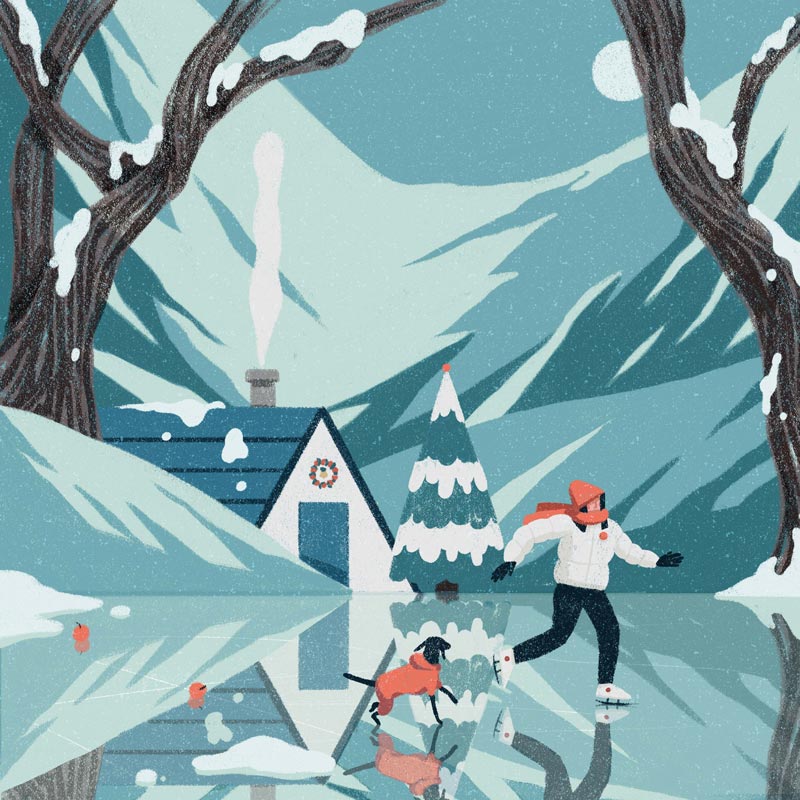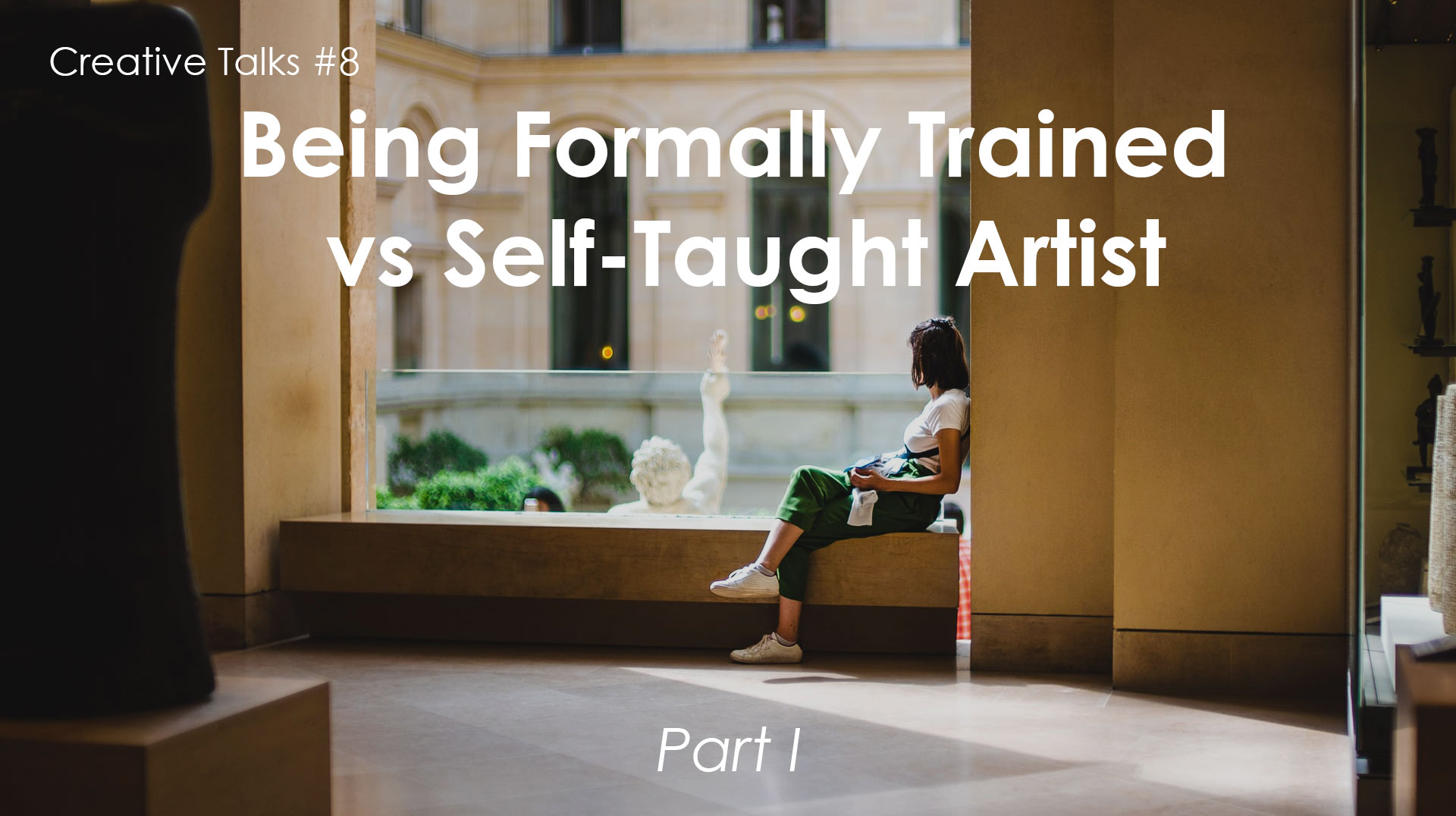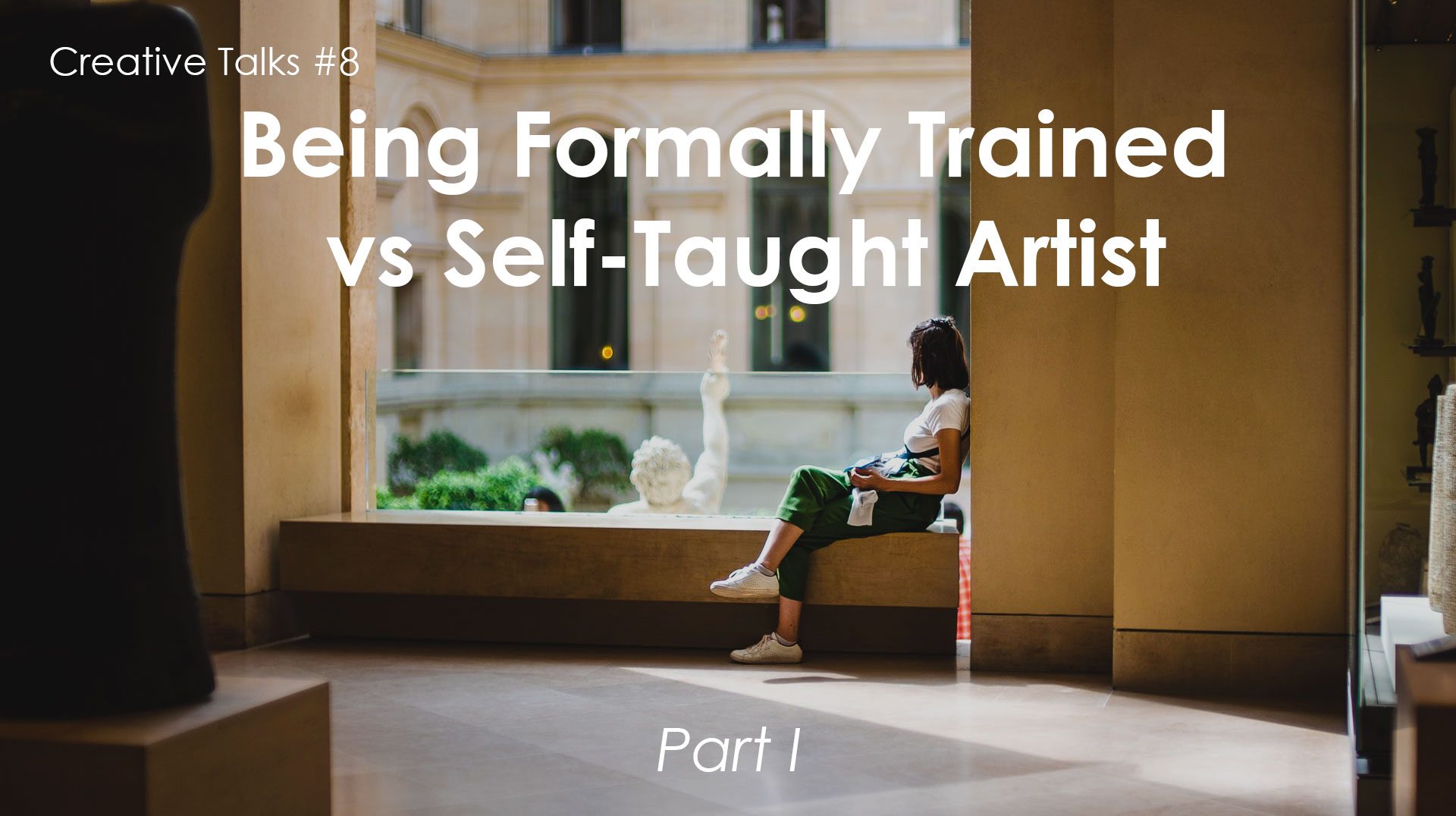I know a lot of people who would like to be the next Van Gogh or Ethel Reed. I mean, who wouldn’t want to be artistic, accomplished, and influential? Another common thing between these artists is that they are self-taught, which shows that formal education is not always the path to success. That’s why a lot of young people wonder what way to choose: go to art school or study on their own.
In this month’s Creative Talks, we would like to focus on this dilemma and present to you what established designers and artists think. Here are the questions that we’ve asked creatives from around the world:
- Are you a formally trained or self-taught artist? Tell us a story of learning your craft.
- In your opinion, what are the major pros and cons of being formally trained or self-taught?
- Which path do you think the novice creatives should take and why? Do you have any advice for beginners?
If you are new here, Creative Talks is the monthly topic powered by Approval Studio, where we ask people from the design and art industry their thoughts on different sphere-related subjects. Earlier on, we’ve covered such topics as things you shouldn’t do while working with designers and why creatives love their job (Part I and Part II).
This time we’ve also got many responses from our lovely creatives, so make sure you check Part II of the article!
Table of contents:
Xuetong Wang – Illustrator
Xuetong Wang’s Website and Instagram
Hi, this is Xuetong, a formally trained illustrator. I graduated from Maryland Institute College of Art Illustration Practice (MFA) in 2020. And before that, I went to Sichuan University for Environment Art Design. I have loved drawing since I was really young. And I would say I was a self-taught artist for a long time before going to art school.

In my opinion, being formally trained has the benefit of being around experienced artists, like your teachers and your classmates. Art school provides a platform to meet people with different backgrounds and thoughts, which means a lot to me. I can learn a lot from them.
And as for self-taught, I would say you can sincerely be yourself and take your own time. Sometimes you will compare yourself to your classmate, and it’s not always a good thing, and sometimes your teacher’s opinions would affect you. At some point, they are right because they are experienced, but I don’t think taking too many opinions from others is suitable for your own expression. And if you are self-taught, this won’t be a problem.
I think passion is the most crucial part of being an artist — no matter whether you are self-taught or formally trained. Passion is indispensable. I know successful artists from both paths. So I think you should pick the one you think is better for you and put your passion into it.
Dany Vo – Multidisciplinary Designer
I am both trained and self-taught. Before becoming a graphic designer, I used to be an artist and illustrator. I started observing nature’s beauty and translated it through drawings and paintings with my artistic lens. I learned to stick close to reality initially and slowly twist the real world to the fantasy world through colors and forms. I also went to school to study illustration, where I mostly create art for myself, and I get pretty comfortable with it. At the end of the program, I asked myself, “what about creating art for people?” so I accepted the challenge and became a graphic designer. I became pretty versatile in terms of crafting, either traditional or computer.

Being formally trained helps people learn their technique a lot faster, and teachers usually help students see their potential and push their students to go beyond where they are currently. I do not see any con to being formally trained.
Being a self-taught designer is great. I think it is where you discover who you are as an artist or designer and own it. However, the con is that you are in your head a lot and often doubt if you are good enough. And sometimes, you are stuck and go in circles to find solutions. As a result, you progress a lot slower. When formally trained, someone will provide you with ideas that you would not think of. It is essential to be both formally trained and also self-taught. It’s the best combination. Learn the rules formally, and then learn how to break the rules on your own!
I would say always stay open-minded and take criticism because it is where you learn. It is ok to disagree but keep it to yourself (whether you like it or not) and maintain open conversations with your teachers or classmates. Listen to people and at the same time listen to yourself and respect your vision as an artist or designer.
Anna Natter – 3D & Graphic Designer
Anna Natter’s Behance and Youtube
Long story short, I spent eight years (high school and college) in art education, where I learned traditional art techniques, art history, and animation as a faculty. But everything after that, I learned by myself. I never attended any course or anything like that for 3D. Everything I know about design, digital art, and 3D I studied on my own. So I have experience with both.
There is no recipe for this, to be honest. I’m a mix of being formally trained and self-taught. The question is – officially trained in what? I would not trade my art school knowledge for anything, and I got such a strong base in the art that I can use in everything I touch. I can use my traditional sculpting training in my VR sculpting now. For example, I studied compositions in paintings and sculptures for a while in school, so I have a good understanding of it, and I can use this in my current 3D renders. So, there is good stuff in things I learned formally for something that I do now. But I can only speak for myself, and other people might have different experiences.

My self-training with 3D is pretty unorganized and emotionally driven, so I learn all kinds of things that I need for my work or my art at a certain moment. And I focus on those things for a period of time. It’s rather experimental, I would say. Sometimes these periods are longer, depending on the software and circumstances. For example, I have used Adobe Dimension for a long time already, ever since it launched, but I changed modeling software multiple times in the meanwhile. I think if you’re dedicated enough, you can learn things by yourself. Especially 3D is an area that is changing a lot, and being up to date is not easy.
So, I see the advantage of being self-taught, but I also see its disadvantage. For someone who can’t focus on something daily and follow through, it’s difficult to keep up with 3D studies as that is an area that requires persistence and won’t give you amazing results in a week. It takes years to perfect your skills in 3D, no matter how you try to learn it. But then again, 3D software is just a tool for creative people, but their vision comes from elsewhere. It’s their personality, their creativity, their history, or their special interests and imagination. And that is the important thing. You can get that extra ingredient that will help you stand out from the crowd, anyone can learn various software, but the way you use it depends on your own personality. So, in my opinion, it’s important to learn different things other than the software to find your own voice.
I would say get the basics right. You can’t build on anything that is simply not there. Learn color theory, composition, and art history if you get the chance. Or whatever your subject is. For example, learn about modern typography but also look after how it started, calligraphy, etc. Learn anatomy if you want to get into character design. These things will help you to put things in perspective. It might seem useless at that exact time you learn about it, but it will come back later for sure, and it will be useful. These basics will also help you to understand design better. The more you see, the more you can learn. I often have this “I’ve seen this before” feeling, and it helped me so much to differentiate myself from other artists by doing things differently. So, in my opinion, the most important question is not how you learn but what you learn.
If you find yourself in situations where communication in the design projects becomes strenuous and far too long, check the design approval tools. They often help with endless emails and give a place for your clients to provide clear and efficient feedback. Approval Studio is one of them! With the help of on-screen annotations, live chats, and a multi-language interface, miscommunication will be in the past.
Baku Hashimoto at INS Studio – Video Director & Visual Artist
Baku Hashimoto’s Website and INS Studio’s Website
To tell the truth, I’ve gone to an art college in Tokyo but dropped out since I failed to earn credits while working as a freelance motion designer. And my major, new media art, was not so relevant to what I’m doing in the aspect of techniques. I’ve almost learned my skills through online tutorials with pirate Adobe products in my teens.

I’m sure that my experience in the art college, such as quarreling with thick-headed professors (sorry, I was so young) at a class and making thingies with friends in the various realms, had formed my attitude to relativize interests and technology in a long-term point of view. Especially in the CGI and motion design industry, so many people seem to focus on just catching up with the trends that can be seen on Vimeo Staff Picks – even though such coolness and photorealism easily go out of date within a half-decade through the evolution of hardware. And I think that such a tendency leads the whole industry to a kind of homogenized state – this is just my observation, though. If I were wholly self-trained by only watching cool videos on Vimeo or Stash and tutorials to recreate them, I would be making bland motion graphics like you can see dozens of times a day on the Instagram timeline. Though I’m not so confident, my works are independent of such a clichéd style.
I definitely cannot say which path would be helpful or not because the situation for learning has been dynamically changing since my student days (though it was only five years ago). I’d prefer an agnostic stance for both ways of learning because of how much various backgrounds every artist in the community has enriches the diversity of expression. But there’s no reason you don’t take advantage of plenty of resources on the Internet.
Yam at Yambo Studio – Creative Director
Yambo Studio’s Behance and Instagram
My name is Yam, and my nickname is Yambo, which has become the artistic name and studio name over time. I’m a self-taught artist, and I’ve been interested in working with electronic music as a child but, over time, got more and more into the visual side. In 2008, I started to work with 3D.
The first step was working with Cinema4D. It was version R11, if I remember correctly, and it was pretty challenging to learn it. So I signed up for a local VFX school in Israel, but the time before the course should’ve started was too long, so I began experimenting with the software alone. As time passed, I realized that there were numerous different resources, and I could make some progress just by digging the internet and finding solutions to the things I need. Eventually, I canceled my attendance at the VFX Course and continued learning 3D & Design alone over the next three years. When I felt ready, I prepared my first showreel and sent it to Tel Aviv production houses. I was accepted for the first one, and the rest is history. The Yambo Studio was founded in 2015, and since then, we are proud to provide endless visual solutions to our different clients.
I think the no-doubt pro of being self-taught is the ability always to explore, grow, and learn over time. Since this is the nature of autodidactism, finding solutions to your problems and learning new things all the time, I think that it’s something that sticks with you and is an excellent tool for life. I feel like I can continuously adapt myself to new technologies and tools. I guess the pros of being formally trained are learning things that you wouldn’t necessarily learn by autodidactism, such as art history, color theory, or typography. I did my best to learn those “boring” topics while learning alone, as it’s also something you should pay attention to, and do not put aside things that are not 100% your interest.
A good piece of advice would be first to choose the right tools. I find so many schools teaching tools that are not relevant for the industry, and it’s a shame. Once you understand which tools you should learn and decide on them, I think a good piece of advice would be to know your resources, whether you are self-taught or formally trained. I believe that having the ability to find solutions to your problems, learn new techniques alone, and grow over time is the key to success.
Bjorn Nelissen – Illustrator
Bjorn Nelissen’s Website and Instagram
I’ve studied at a technical school in Graphic Techniques & Desktop Publishing and also at the Academy of Fine Arts in Maastricht. I actually started my training when I was 14 in high school, where the school offered a course in decorative painting techniques and graphic arts. I wanted to become a commercial illustrator when I was ten years old, and at that time, I did not know any better than to become an illustrator by being educated into one.

A pro for formal education is that you’re surrounded by like-minded people and teachers who can be a huge inspiration for you at school. A downside of a strong educational base is that knowledge can also stand in the way of coming up with fresh and innovative solutions. This is true, especially in the arts, I think. Self-taught artists have to find everything out the hard way, but the internet makes it so easy to connect with other artists. Youtube and websites like Schoolism and Lynda are packed with all the practical information an artist needs.
In my opinion, the most successful artists are the ones who have the strongest opinions, so I would definitely advise getting opinionated about the more significant issues in the world. Plus, find a way to deal with criticism. Negative ánd positive. And lastly, draw as much as you can. Draw not to make pretty things but to understand things better as perspective, composition, and shape.
Zoltán Visnyai – Graphic Designer
Zoltán Visnyai’s Behance and Instagram
I would say I am both self-taught and formally trained. Like many graphic designers around me, I always liked to draw and create stuff, and it slightly turned to graphic design at a certain point (before I got to know what graphic design is). This point was to make illustrations for my high school magazine when I was 14 and later design the magazine’s visual identity. It was quite unexpected, so I had to get some information about typography, basic rules, tricks, so the self-teaching started with trailers and books and never ended since that point.
In parallel, I took on different tasks in school, for example designing posters for events. However, I felt I needed some coordination and feedback, so I started a two-year-long course and then the Hungarian University of Fine Arts. There, I mostly expected to get a theoretical and intellectual boost for my work in a lovely community. Surprisingly it helped me a lot to move out of my comfort zone because you can only handle many tasks if you are looking for a varied mode of communication. I feel that university made me even more receptive to the fine arts, with graphic artists and painters around me providing amazing inspiration.

The biggest pros of formal education are the deadlines (seriously) and the professional community. These give a natural competition. Deadlines can help assess the time ahead of you and plan to do your best in a particular period. A professional atmosphere represents different approaches to the same problem or task, and it’s beneficial. The pros of being self-taught are that you can follow your path in your tempo. You can speed up or slow down sometimes and do precisely the kind of graphics you want. The Internet is full of free or affordable tutorials, and Instagram is there as an unlimited source of inspiration. But both have cons, like fixed timetables or the difficulties of immersion in more special topics respectively.
I think there are more keys to achieving your goals, and you have to choose the path which suits your personality. It may sound corny, but true. For me the formal training helped, I can recommend that. It doesn’t have to be a university; a course for adults can be perfect for starting. Find some smaller jobs to improve your communication skills. Some graphic work can help beginners a lot, and I found that a really great practice to meet with a real customer and brief. Check many projects on your favorite platforms – it can be Instagram, Behance, Pinterest, or Facebook group – and observe what you see. Why do you like something or why not? What makes that design alive? How would you start to think about the same problem? Make some goals for yourself, like spend an hour every day practicing logo design for a month. The important thing that may sound strange: take breaks, don’t spend time just with graphic design. Get inspiration from books, music, theatre, nature, people.
Final Thoughts
As always, a huge thank you to all of the creatives who took the time to write their thoughts. I’m sure that it will help many people who are at a crossroads in their early careers. You’re wonderful!
All in all, most of the answers underline the major idea that you have to find your own path in life, whether it is being formally trained or self-taught, or both. It’s vital to follow your gut feeling and understand what you will get from either of these options. Genuine learning is what matters the most, no matter the way. And with a healthy amount of passion and perseverance on top, you can also become the next Van Gogh or Ethel Reed!
For those of you who want to read a bit more on this topic, here is Part II. And if you are eager to take part in our next article, please feel free to contact us here or via [email protected].
Cheers!

 TEAM SOLUTIONS
TEAM SOLUTIONS WORKFLOW SOLUTIONS
WORKFLOW SOLUTIONS



 REVIEW TOOL
REVIEW TOOL PROJECT MANAGEMENT
PROJECT MANAGEMENT TOOLS & INTEGRATIONS
TOOLS & INTEGRATIONS
 CLIENT INTERVIEWS
CLIENT INTERVIEWS









